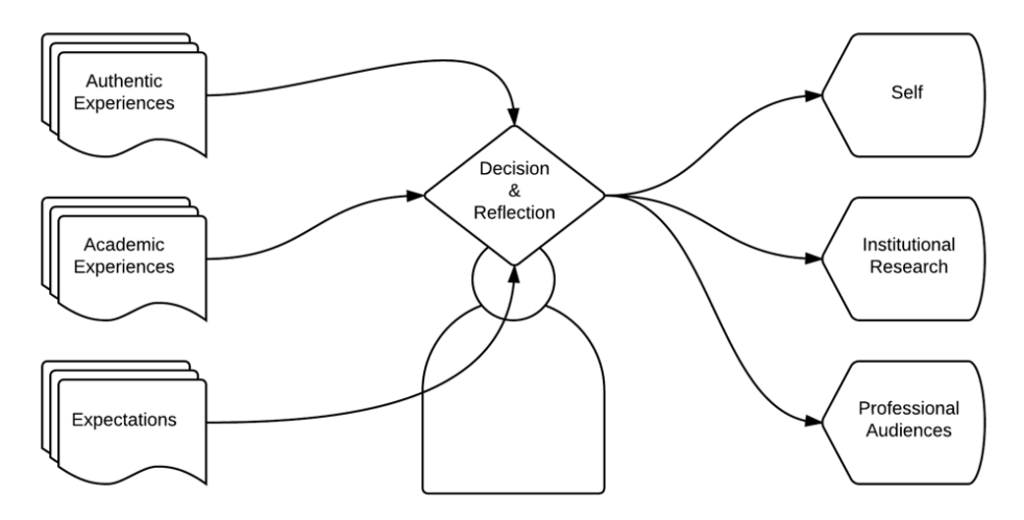At several time over the last 20 years, I have helped schools create electronic portfolio projects– I wish these had been more sustained, but I’ve found there is a vast disconnect between what educators think they will be and what they really are. I discovered this summary of eportolfios that I prepared for a specific audience a few years ago… this seems a good place for it to see the light of day again.
Portfolios are “creations of the creator.” The individual who is compiling the portfolio makes all decisions about what to include, why it is meaningful, and the acceptable uses of it. The single area in which the creator exerts little control is the expectations and some aspects of the organization. Otherwise, the portfolio is a metacognitive device. It reflects the individual creator’s perceptions of his or her emerging skills, knowledge, and habits.
Portfolios comprise three inputs: authentic experiences, academic experiences, and expectations. Expectations communicate to the creator which skills, knowledge, and habits are important and contributes to the organization of the portfolio through providing labels for tabs, pages, or sections. In school settings, artifacts academic experiences from the formal curriculum contribute to the portfolio, but artifacts from complex and authentic experiences are most-frequently included.

- Authentic Experiences: When learners engage in practical and complex activities in which performances are for general audiences and the work resembles that encountered in professional setting, they are gaining authentic experiences. Internships, service learning, project-based learning, and co-curricular activities are all examples of activities that provide authentic experience.
- Academic Experiences: Work that is created primarily for teachers or others in the relatively closed community of the school are academic experiences. Some educators find it distressing when students use rather few of these in portfolios.
- Expectations: Are defined by the standards or other documents the indicate to the individual creating the portfolio what they should demonstrate in the portfolio. As learners near the end of their scholastic careers, they transition from expectations that arise from school curriculum to those that arise from professional standards.
The individual who creates the portfolio makes decisions about which of their experiences best illustrate the skills, knowledge, and habits in the expectations; also the individual is responsible for composing reflections to detail the meaning of each artifact. Mentors have an advisory role and can assist with mechanics, but decisions are made solely by the individual.
- Decisions: For most portfolio creators, there are many artifices that have been collected which could demonstrate their best and their typical level of performance in any expectation. Educators and other mentors can make recommendations about appropriateness of artifacts and have an important role in supporting the collection and culling of artifacts, but the selection decision are made solely by the individual.
- Reflection: To differentiate a portfolio from a scrapbook, creators reflect on the artifacts to establish the meaning of the artifacts relative to his or her emerging competence and to establish connections to the expectations. These brief (two to three paragraph) compositions are written by the individual. Mentors can suggest prompts to scaffold reflections and they can provide support to ensure the reflections are mechanically and grammatically correct, but the composition of reflection is solely the work of the individual.
The portfolio is created for three audiences; some parts of the portfolio may be adapted for different audiences, and the relative importance of each audience changes over time.
- Self: Regardless of the age of the individuals preparing the portfolio, the individual is the primary audience. By compiling a portfolio, an individual is making statements regarding what they believe they know and can do.
- Institutional Research: A sample of portfolios can form a valuable data source for leaders to understand the outcomes of their institutions. Because portfolios comprise the individuals’ perceptions of themselves, they provide a data from an otherwise difficulty to gather point of view. In some instances, artifacts are included in the portfolio for institutional research purposes (test scores, common assignments, and service records are common examples). These items are typically added to a separate section of the portfolio, and removed when the portfolio is prepared for professional audiences.
- Professional Audiences: Just as authentic artifacts form the foundation of portfolios, the professional audience is the primary purpose for creating a portfolio. Depending on the goals of the individual, the professional audience will vary. College admissions professionals may find these useful in making decisions. (Two individuals who are enrollment deals for four-year colleges have concurred with the statement, “even if I don’t see this, someone who creates a portfolio will be better prepared for the college admission process.”) Employers may review this in recruitment. Especially in graduation situations, portfolios may be reviewed by professionals working the field the creator hopes to enter.
